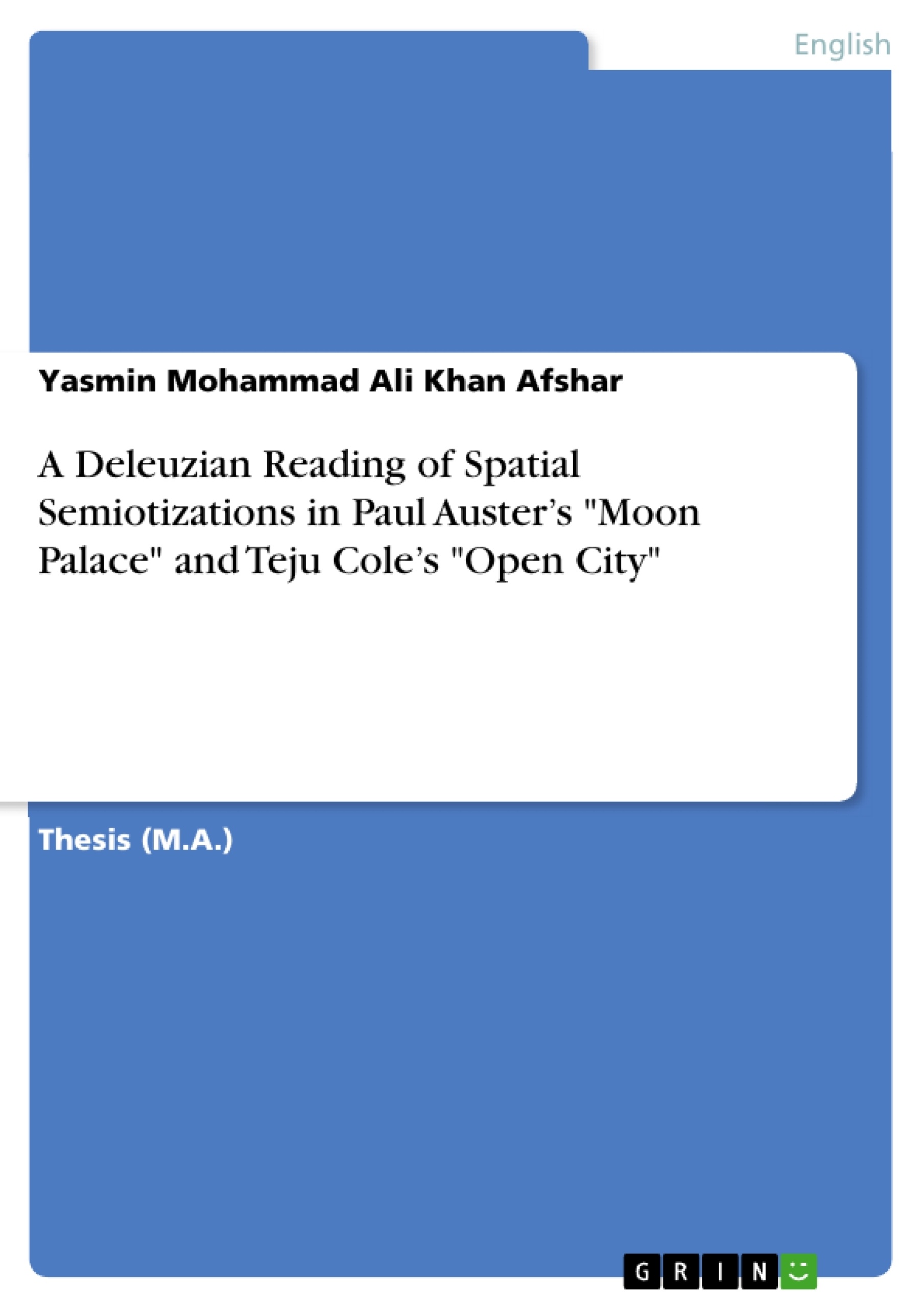The increasing attention paid to figurations and poetics of spatiality within literary texts in the course of the so-called spatial turn calls for a closer integration of urban space research, literary studies and memory research. In an age of ever faster communication processes and a seemingly shrinking globalized world, spatial considerations are not only informative for the analysis of intrinsic textual strategies, but are also indicators of the formative discourses of the environment in which they are produced. The connection between semiotics, postmodernism and capitalism is thus central to a consideration of urban space and its contemporary negotiation in literature. Using the aforementioned approaches and in the context of a Deleuzian understanding of space, this thesis examines the semiotic construction of spatiality in two novels: Paul Auster's “Moon Palace” (1989) and Teju Cole's “Open City” (2011).
Inhaltsverzeichnis (Table of Contents)
- 1. Introduction
- 2. Literary Studies after the Spatial Turn
- 2.1. Reading the City as Text - The Spatial Turn and the Semiotics of Space
- 2.2. Towards a Fusion of Urban and Literary Studies
- 3. Language, Body and Space in Paul Auster's Moon Palace
- 3.1. Spatializing the Body
- 3.2. “Tell me what the clouds look like." - Semiotic (Re-)Construction of Space in Moon Palace
- 3.3. Subverting the Postmodern? (Modernist) Bodily Existence vs. (Postmodern) Disorientation and Fragmentation
- 4. Teju Cole's Open City – Rewriting the City
- 4.1. Multi-layered Text-Spaces and the City as Palimpsest
- 4.2. New York City as Deterritorialized Space of Migration?
- 4.3. Third Space Experiences – Narrating Spatial Conflicts
- 5. Deleuze and Guattari's Philosophy of Space and Literary Spaces in Moon Palace and Open City
- 5.1. Moon Palace and the Rhizomatic: Contesting the American Self-narrative of Manifest Destiny
- 5.2. Palimpsest – Rhizome – Open City: Spatial Semiotizations of the Urban in Open City
- 5.3. De- and Reterritorializing Processes, or: Crisis and Reterritorialization/Recuperation
- 5.4. Smooth and Striated Spaces
- 6. The Poetics of Sacred Space - Reinscribing Ruinous Body Textualities
- 6.1. Figurations of Individual and Collective Crises
- 6.2. 'There is no place like home' – The Production of Absolute Topologies
- 6.3. Patriotism and the Sacred Space of Home(land)
Zielsetzung und Themenschwerpunkte (Objectives and Key Themes)
This thesis aims to conduct a comparative analysis of Paul Auster's Moon Palace and Teju Cole's Open City, focusing on their representation of space and crisis within the framework of postmodernism. It explores how these novels utilize spatial semiotics to depict the anxieties and transformations of American identity in their respective historical contexts.
- Spatial representation in postmodern literature
- The city as a textual space
- Crisis of identity in relation to space and time
- The American self-narrative and its deconstruction
- Deleuzian concepts of space and their application to literary analysis
Zusammenfassung der Kapitel (Chapter Summaries)
The introduction establishes the comparative framework for analyzing Moon Palace and Open City, highlighting their shared engagement with spatial representations of crisis. Chapter 2 reviews relevant literary theory, particularly the "spatial turn" and its implications for urban and literary studies. Chapter 3 examines the spatialization of the body and the semiotic construction of space in Moon Palace, while Chapter 4 undertakes a similar analysis of Open City, focusing on its portrayal of New York City as a palimpsest and a space of migration. Chapter 5 applies Deleuze and Guattari's philosophy of space to both novels, exploring concepts like the rhizome and territorialization. Chapter 6 delves into the poetics of sacred space and the representation of individual and collective crises within the novels.
Schlüsselwörter (Keywords)
Postmodernism, spatial semiotics, urban studies, literary analysis, Paul Auster, Teju Cole, Moon Palace, Open City, Deleuze and Guattari, American identity, crisis, space, city, text, body, ruin, manifest destiny, migration, palimpsest, rhizome, territorialization.
- Citar trabajo
- Yasmin Mohammad Ali Khan Afshar (Autor), 2014, A Deleuzian Reading of Spatial Semiotizations in Paul Auster’s "Moon Palace" and Teju Cole’s "Open City", Múnich, GRIN Verlag, https://www.grin.com/document/1509100



